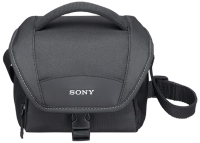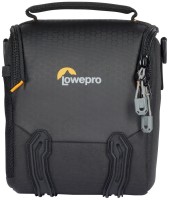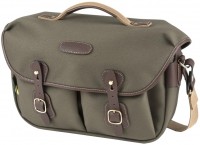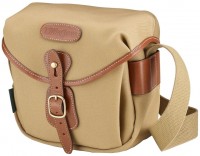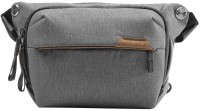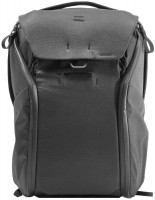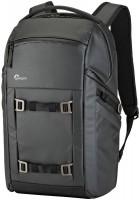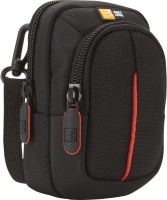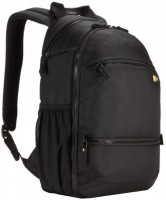Camera Bags Vanguard
All Camera Bags Advanced filters → |
You might be interested in
Camera Bags: specifications, types
Features
— For cameras (SLR). Bags or other protective gear designed for SLR cameras. These cameras are much larger in size than most compacts; in addition, when using them, you have to deal with a lot of removable accessories — lenses, flashes, boosters, etc. With this in mind, products for this purpose should have good capacity, and ideally also compartments or external pockets for additional equipment. On the other hand, there is no official division into bags for SLRs and compacts, so in this case it is rather arbitrary. In our catalog, models for SLR cameras include two types of products: first, those in which the size of at least one of the dimensions is 150 mm or more; secondly, those in which special equipment is provided, such as a separate pocket for the lens (regardless of the dimensions of the bag).
— For cameras (compacts). Bags designed for use with compact cameras. In addition to their small size, such cameras are also characterized by battery life — in the sense that everything necessary for shooting is usually built into the device itself: non-removable optics, its own flash, etc. Therefore, bags for compact equipment do not need large sizes and additional pockets / compartments. Therefore, in our catalog, compact models include all products whose dimensions do not exceed 150 mm, and the design does not provide special “mirror” equipment (for more details on such equipment, see above).
...
— For video cameras. A bag for a video camera, designed to protect against mechanical damage and accidental shock. They can be additionally protected by a frame made of plastic or metal, which gives additional rigidity. A variety of materials are used for manufacturing. Equipped with additional inner or outer pockets.
— For lenses. The bag is designed to protect interchangeable lenses of photo and video devices.
— Case for tripods. Cases are available in different sizes (length) to fit a variety of tripod heads. The wardrobe trunk, usually, opens with a full-length zipper, which allows you to quickly put in or take out a tripod. Often, moisture-proof materials are used for manufacturing.
— For cameras (compacts). Bags designed for use with compact cameras. In addition to their small size, such cameras are also characterized by battery life — in the sense that everything necessary for shooting is usually built into the device itself: non-removable optics, its own flash, etc. Therefore, bags for compact equipment do not need large sizes and additional pockets / compartments. Therefore, in our catalog, compact models include all products whose dimensions do not exceed 150 mm, and the design does not provide special “mirror” equipment (for more details on such equipment, see above).
...
— For video cameras. A bag for a video camera, designed to protect against mechanical damage and accidental shock. They can be additionally protected by a frame made of plastic or metal, which gives additional rigidity. A variety of materials are used for manufacturing. Equipped with additional inner or outer pockets.
— For lenses. The bag is designed to protect interchangeable lenses of photo and video devices.
— Case for tripods. Cases are available in different sizes (length) to fit a variety of tripod heads. The wardrobe trunk, usually, opens with a full-length zipper, which allows you to quickly put in or take out a tripod. Often, moisture-proof materials are used for manufacturing.
Product type
— Case. Provides minimal protection - mainly from dust, scratches and (sometimes) moisture. Well suited, for example, to be carried by hand or in a larger bag along with other things. The advantage of covers is compactness and small weight.
- Case. Made in the form of a pencil case. In the middle there are different departments, both for the camera itself and for various accessories, such as additional memory cards, a battery, a cloth for cleaning the camera or its optics. It is made from fairly rigid materials.
- Bag. Classic bags are very versatile, well suited for any travel, usually have additional internal and external compartments. The thick and soft materials that most bags are made of provide some degree of shock protection even in the officially ''non-shock proof'' models. As a rule, they are equipped with a carrying handle and a shoulder strap.
— Backpack. Dedicated backpack with camera compartment. As a rule, they are made of waterproof materials. They are very convenient when transporting, as they allow carrying on the shoulders. Sufficiently capacious, in addition to photo and video equipment, they are designed for a variety of additional things.
— Case. They have the highest degree of protection compared to other types of camera bags. As a rule, they are made of metal, aluminum is most...often used; when using textile or leather materials, a stiffening frame (plastic, metal) is added to the structure. The case can easily accommodate photo-video equipment and a set of lenses for it.
- Suitcase. Models of various shapes and types, which are equipped with wheels. As a rule, they are designed to carry not only photo and video cameras and accessories, but also a fairly large number of additional things. This option is useful for tech who have to travel frequently.
- Case. Made in the form of a pencil case. In the middle there are different departments, both for the camera itself and for various accessories, such as additional memory cards, a battery, a cloth for cleaning the camera or its optics. It is made from fairly rigid materials.
- Bag. Classic bags are very versatile, well suited for any travel, usually have additional internal and external compartments. The thick and soft materials that most bags are made of provide some degree of shock protection even in the officially ''non-shock proof'' models. As a rule, they are equipped with a carrying handle and a shoulder strap.
— Backpack. Dedicated backpack with camera compartment. As a rule, they are made of waterproof materials. They are very convenient when transporting, as they allow carrying on the shoulders. Sufficiently capacious, in addition to photo and video equipment, they are designed for a variety of additional things.
— Case. They have the highest degree of protection compared to other types of camera bags. As a rule, they are made of metal, aluminum is most...often used; when using textile or leather materials, a stiffening frame (plastic, metal) is added to the structure. The case can easily accommodate photo-video equipment and a set of lenses for it.
- Suitcase. Models of various shapes and types, which are equipped with wheels. As a rule, they are designed to carry not only photo and video cameras and accessories, but also a fairly large number of additional things. This option is useful for tech who have to travel frequently.
Capacity
The total volume of the bag, as a rule, includes all regular pockets (including external ones). However, manufacturers can indicate the volume of only the main compartment. A large volume allows you to put a lot of things inside the camera, but it significantly affects the dimensions, weight and price of the product itself. Therefore, when choosing, you need to strike a balance between capacity and convenience.
Compartments for photographic equipment
When choosing a camera bag, pay attention to the size of the camera compartment. This compartment is designed for storage and safe transportation of photographic equipment, and has dense and soft protective walls. The larger the size of the camera and the number of lenses / photo accessories used, the larger and more spacious the compartment for storing them should be.
Removable partitions
In semi-professional and professional models, the camera / lens compartment is equipped with removable soft partitions. This allows you to adjust the interior space of the compartment to your liking.
Increase in internal capacity
The possibility of increasing the internal volume of the bag at the request of the user. Most often, it is implemented due to a special zipper, when unzipped, the bag “unfolds”, increasing in size and, accordingly, in volume. This feature is useful primarily for those who have to deal with several cameras of different sizes. For example, for a compact amateur camera, a folded bag will be enough, which will not take up extra space, but for an advanced camera with a set of optics, the bag can be expanded and everything will fit.
External compartments
The outer compartment is designed to store small personal items/photo accessories and quickly access them. Usually, it is fastened with a zipper or Hook-and-loop.
Laptop/tablet compartment
Designed for storage and safe transportation of a laptop/tablet. Has dense and soft protective walls.
Personal items compartment
Designed to store small personal items and photo accessories.
MOLLE/PALS system
Mounting system for fixing various additional “body kit” on a backpack / bag - pouches, first-aid kits, cases with flasks and devices, etc. The official name of such a system is PALS, but colloquially it is also known as MOLLE. Outwardly, such a mount looks like a set of characteristic horizontal strips (slings) made of nylon, separated by vertical seams into separate "cells"; the number of such bands and cells may be different. Initially, PALS appeared in military equipment. The key convenience of such a latch is that the customer can choose the places for attaching additional cargo to the slings. However, it should be borne in mind that in some products, the dimensions of the lines may not comply with the official PALS standards; and in some places the slings are generally a purely decorative element. These nuances must be clarified before buying.
Chest strap
Attachment in the form of a strap with a clasp that connects the main straps of the backpack at the level of the user's chest. When fastened, such a strap keeps the straps at the same distance from each other and does not allow them to “scatter”. This provides additional convenience in the distribution of weight, as well as a secure fit on the body: it is almost impossible to remove the backpack without unfastening the strap. To adjust to a specific user , the chest strap is often made adjustable.
Belt
An additional device in the form of a belt, which, when fastened, covers the user's body in the area of \u200b\u200bthe belt. The main function of the waist belt is to redistribute the load: it allows you to transfer the load from the shoulders to the pelvic area, which is especially convenient when wearing for a long time and carrying heavy loads. In addition, such a device provides additional reliability of fixing the backpack on the body.
Tripod mount
Special belts are designed for attaching a photo tripod or monopod to a bag / backpack, for their more convenient transportation.
Bottle pocket
Special niche for a container with liquid. Can be used as an extra pocket.
USB interface
Standard USB connector located on the outside of the product. Allows you to charge smartphones, tablets and other gadgets without unpacking your backpack - the main thing is that you have the appropriate cable at hand. Of course, for such charging, you will need a power bank or other source of energy connected to the USB port from the inside; such a source is usually not included in the delivery set.
Hand strap
The strap is short, designed for easy transportation. Wears on the wrist.
Carrying handle
Used for manual transportation of the photo bag.
Belt clip
Used to carry a small bag/camera case/lens on your waist belt.
Carabiner mount
Used to attach a bag (camera case) to the neck/shoulder strap using a metal carabiner.
Trolley sleeve
For convenient and safe transportation, most modern bag models are equipped with a special belt (or a special through compartment) on the back side, with which the bag is securely attached to the retractable handle of a travel suitcase or luggage trolley.
Shoulder strap
It is used for transporting a photo bag, in the position "on the shoulder"(over the shoulder).
Shockproof
Bags with such a body protect sensitive photographic equipment inside from strong shocks and shocks. Usually they allow you to endure falls from a height of about 1-1.2 m without consequences, however, the specific characteristics and protection capabilities of different models differ, they should be specified separately.
Raincover included
Designed to protect the contents of the photo bag from adverse weather factors (rain, snow). Usually, it is located in a small department specially allocated for this.


